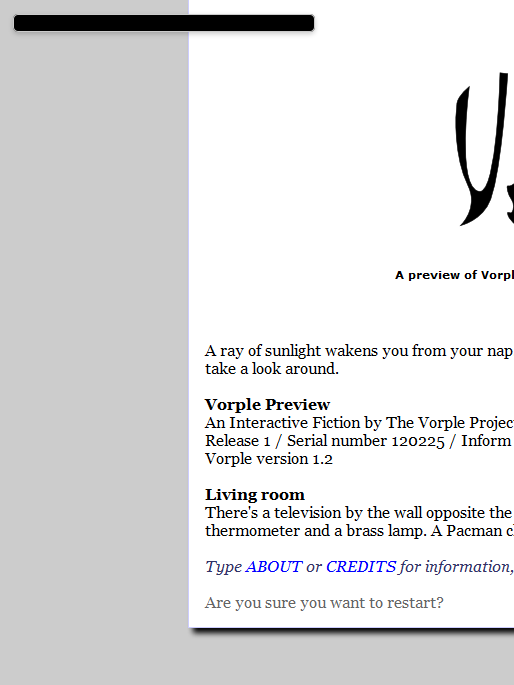As you might already know, I’m building a web user interface library called Vorple that includes, among other things, new features for Parchment. It would be nice to get some feedback regarding these features before making it available to the public.
Below there are direct links to versions that demonstrate the features discussed, but you can also build your own set here with a bit more options. If you have an idea that’s not covered here and if it can be easily implemented, I can add it to the demo so you can see how it looks like live.
If you could look at the given options and tell which of them (if any) seem like the best ones, that would be great. Ideally the story author could tweak the features if needed, so for each feature try to think what would be the best default setting.
[size=150]Parser errors[/size]
To keep the transcript clean of anything that’s not actual gameplay, parser errors are “folded” away: the error message is hidden from the screen the next turn. Another option is that the error messages are not displayed in the story text at all, but shown as tooltips or notifications.
A rather interesting option would be to hide the errors only after they’ve scrolled off screen. The player would never see them folding away but they would be hidden in the scrollback. My intuition says that this would be more confusing than useful, but it’s included here as a demo anyway.
When the errors have been folded, the player’s command is left in the scrollback. Hovering the mouse over the command shows the error message as a tooltip and clicking the command returns the error message to the scrollback. Having both seems redundant, so it should be either of them (or some third option). The tooltip could also be displayed not on hover but on click. All the demos below use both methods.
Demos:
- Folding the next turn (give an invalid command and then some other command)
- Folding after scrolling off screen (give an invalid command, then give so many commands that the error message scrolls off screen, then scroll up to see it hidden)
- Shown only as a tooltip
- Notifications: top left, top right, bottom right, top bar (bottom left and bottom bar would cover the prompt)
[size=150]Meta commands[/size]
Similarly to keep the transcript clean meta commands are displayed in a separate notification outside the story text. No traces of meta commands are left in the story text.
Demos (try commands VERSION or BRIEF, for example):
- Notifications: top left, top right, bottom right, top bar
- Modal notification (must click or press a key to dismiss the notification. The enter key doesn’t work properly in the demo, so don’t mind that for now.)
[size=150]Undo[/size]
Undoing hides the action that it undoes. The action’s command is left in the transcript and the word “i[/i]” is added to it. Again, the hidden action should be somehow recoverable, and it’s done either by clicking or showing a tooltip just like with error messages. All the demos above have both options.
(Remember to give a valid command before undoing. The demo isn’t yet smart enough to understand that the intro text is not something you can undo, so if you undo the first turn it will clear the intro text…)
[size=150]Dialogs[/size]
Some meta commands can be displayed as dialogs, popup screens that have to be dismissed manually. No actions or commands default to dialogs, so it’s up to the author to decide when to use a dialog to display the command and how the dialog behaves. Typically you’d use dialogs to display information like the ABOUT text, as opposed to just confirming that the player’s meta action was acknowledged like with SAVE or VERBOSE. Try CREDITS, ABOUT or TIPS in any of the demos to display a dialog.
[size=150]Other[/size]
There could be a default “how to play” link that would display PR-IF’s How to play IF card. Authors could replace the link with their own story-specific help or remove it completely. Does this sound like a good idea?
Other comments about the layout? Font, text size and line spacing? Margins and page width? Should the text be fully justified? Do you prefer Parchment’s all-white background or Vorple’s white block on gray background?
Note that there are some glitches in the demo like extra line breaks and twitchy auto-scrolling in some browsers. They’ll be ironed out in the final version.
Thank you for your comments!


